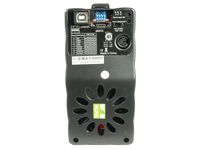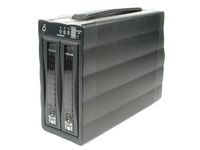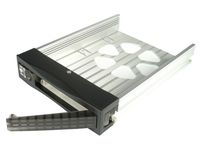Comparing External RAID Housings
Superbox / Jou Jye ST-2320S/UES
The Superbox / Jou Jye ST-2320S/UES housing for two drives left us with mixed feelings. The carry strap appears a little strange initially, and the barely one kilogram heavy housing feels too light-weight to to really be solidly-built. Like the G-Force Megadisk MDE1000, the ST-2320S/UES has an external power supply. The power consumption of just one watt when switched off is also low. The maximum power consumption was determined during a RAID 1 rebuild, and measured 23 watts. The power consumption in idle is 18 watts.
The Package
The scope of delivery is respectable with a USB and eSATA cable, an external power supply plus cable, a detailed operating manual, screws for fitting the disks, and a CD-ROM that contains a range of drivers for USB controllers under Windows 98. Backup software is not supplied.
Installing The Drives
The drive cages are very light, but still stable. Only the plastic lever used to anchor the cage in the housing does not inspire confidence. The plastic locking and closing mechanism is also a little worrying. To unlock the drive cage, you must press the locking mechanism. A small rotating button can be turned through 90 degrees to lock and prevent unlocking. If you turn the button, however, you invariably unlock the drive cage, as the mechanism for opening the drive cage moves very easily.
Selecting The Operating Mode
The various configurations in which the ST-3220S/UES can be operated are the same as for the SansDigital Mobilestor MS2UTN+: RAID 0, RAID 1 or JBOD. Here, though, the operating modes are not set using a rotating button, but rather with DIP switches like the ones used on older motherboards and dot matrix printers. The currently-selected configuration is shown on the small display on the front of the unit. The fan speed can also be set manually to high or low.
Get Tom's Hardware's best news and in-depth reviews, straight to your inbox.


Current page: Superbox / Jou Jye ST-2320S/UES
Prev Page SansDigital Mobilestor MS2UTN+ Next Page Test System-
Aragorn Did anyone else think that the thumbnails of the charts were utterly useless. Why don't we get nicely sized images in THG reports anymore?Reply -
Discussion about external desktop storage and no mention whatsoever of Firewire? *yawn* call me when you have a serious storage article. Firewire is the defacto standard in the pro desktop market, and also of course with all Apple systems. It's faster than USB 2.0 in every benchmark. It's more flexible and mature than eSata. And with Firewire 3.2 Gb/s coming later this year, it's about to get reeeeally fast. I have five external disks (including 2 raid arrays) and all are Firewire 800 connected.Reply
-
hawler I wish firewire would just die with the upcoming release of USB 3.0 which will be fast 4GB/s and more common. It really is annoying to have both of these on a computer when you could simply have just one of them. Id rather have 10 USB slots then 8 USB and two firewire on my computer. I knwo this isn't goign to happen but there simply is no need to have both, I realize currently it is faster but it won't be soon, and when it was first made they should have tried to make it a new version of USB so that there wouldn't be 2 standards.Reply
Thats just my opinion on it, im sure people who use a lot of firewire products (i only use it for my ext HDDs but) might disagree but the idea of having just one I/O choice to me is better...its like display port for monitors...why oh why didn't they just leave it with DVI/HDMI -
@ hawler: USB is NOT a replacement for firewire! There's a reason that ALL pro audio equipment uses Firewire instead of USB. There's a reason that ALL camcorders can stream video only over Firewire and not USB.Reply
It's called "Isochronous transfers". Critical when you're dealing with real-time audio or video. USB doesn't provide that. Also makes bulk data transfer (like backups, for instance) perform more consistently.
USB was never designed for bulk data transfer. That's why it sucks so badly at it. Ever wondered why a 480 Mbit USB2 connection (That's 60 MB/s) can barely achieve between 35 MB/s in real world transfers? That's because the protocol sucks at bulk data transfer. USB was designed for keyboards and mice. To replace low-speed serial ports. Not for high speed bulk data transfer. The USB protocol is inherently deficient in this regard.
Firewire, on the other hand, was designed *specifically* for bulk data transfers. It's obvious when you look at its efficiency at these kinds of tasks. Firewire 400 (that's 50 MB/s) achieves around 42 to 45 MB/s in real world performance. Far FAR more efficient than USB at moving data.
My vote would be for ALL external data storage, audio, and video devices to be firewire only. Make everything else USB. -
njalterio For those of you asking about firewire, many companies do not like to use firewire because of security issues. Firewire devices communicate through direct memory access. There is no operating system intervention. This is why many companies will have their IT staff remove firewire expansion cards or disable them.Reply -
@ njalterio: Companies? IT departments? What kind of company IT department directs their employees to backup the PC's individually using external disks??Reply
Firewire does indeed use DMA. That's another advantage it has over USB, at least in terms of performance. Everyone knows from back in the PATA disk days, that DMA transfers are way faster than non-DMA transfers.
But for professional audio/video, there is only one option and that's Firewire. No such thing as pro a/v products that use USB. They just don't exist. So when you say that "companies disable fw interfaces" I suppose it depends on what sort of company you're talking about. Not a production studio that's for sure!! -
xxsk8er101xx There is this program called Hotswap 4.0.1 i think it is. or maybe 4.1.1. I forget. But it's called Hotswap and it allows you to have that add/remove icon for harddrives. It works for cd-roms, ide drives, fixed drives ... it's an amazing program and best of all - it's free!Reply
Again it's hotswap! 4.'something ... http://www.softpedia.com/get/System/OS-Enhancements/HotSwap.shtml it's an amazing tool and it works very well. Solves the problem listed on page 1 about no add/remove icon. -
GreenPower All my applications are installed on the C drive, which is a 500GB $79 WD unit. I buy a second identical drive and hook it up to an extra 18" sata cable and power right at the edge of the pc case chassis.Reply
I use Acronis True Image disk utility to make and exact copy when the system half way reboots. Then I turn off the power and swap disks. A few applications like Photoshop can still detect they have been copied. But besides this its a 5 minute replacement if my HD ever gets corrupted.
Otherwise it takes about 4 LONG days to rebuild the system from scratch.
Five minutes vs four days. Go figure! -
GreenPower Always run the long format and surface scan any new disk to check for bad sectors. Then re-scan it after its been copied and re-booted with. Only then can you state that you backup is worthy.Reply




